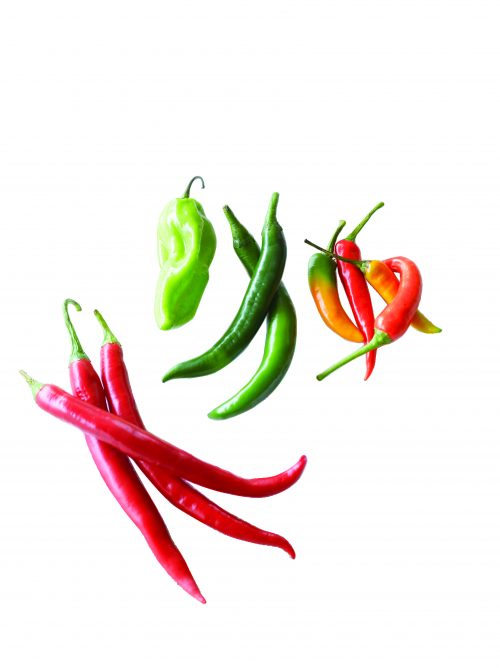
What are chillies?
Chillies are part of the capsicum family. They are readily available in supermarkets and vegetable stores in various shapes, sizes and colours, ranging from tiny, hot birdseye chillies to large fleshy chilli peppers with a mild flavour.
Chillies have little aroma but they vary in taste from mild to fiery-hot. Generally, large flat round fleshy varieties are milder than small, thin-skinned pointed types. Capsaicin, which is present in the seeds, veins and skin, gives chillies their kick. The amount of capsaicin varies depending on the type and ripeness of the chilli.
Chilli nutrition
Studies have found that capsaicin – the active compound in chillies – may increase metabolic rate. Regularly adding chillies to your meal may also help control blood glucose levels.
Buying
Choose fresh, firm unblemished chillies. Avoid chillies wrinkled in appearance or marked or bruised.
Storing
Store fresh chillies in a tightly-sealed plastic bag in the fridge. Keep ground chilli powder and dried chilli flakes in an airtight container in a cool, dark place.
How to use
Chillies are usually finely chopped for use in cooking. The longer a chilli is cooked, the hotter the flavour will be. Simmering chillies in a dish such as Chilli con carne or Spaghetti bolognese will result in a dish with a hot overall flavour. Adding chillies to dishes at the end of cooking will give more subtle heat and chilli flavour.
Stir-frying finely chopped chillies will add flavour and bursts of hotness to dishes as well as adding colour.
Complementary chilli flavours include coriander, basil, ginger, cinnamon, black pepper, cumin and parsley.
How to prepare
- Use a sharp knife to cut chilli in half lengthways to expose the seeds.
- If you prefer less heat, remove seeds by using a small spoon or sharp knife to pull them away to discard. Finely chop chillies. Use as required.
Chilli tips
- As a general rule of thumb, the smaller the chilli the more explosively hot it is.
- When handling chillies wash your hands well and avoid touching your eyes or any sensitive areas. If you have particularly sensitive skin or particularly hot chillies, wear rubber or disposable gloves.
- Clean chopping board thoroughly after preparation to prevent chilli flavours transferring to other foods.
- Chillies can burn. Soothe a sore mouth with plain rice, bread or beans. Do not drink water: it will make the burning worse. Milk and yoghurt can help counteract the burn from chillies. This is why yoghurt-based sauces are often served with Indian curries.
Types of chillies
- Serrano chillies are the most commonly found chillies in the supermarket. They are milder than habanero and birdseye chillies. Generally they are red or green.
- Habanero chillies: These lantern-shaped chillies can be various colours. They are extremely hot.
- Birdseye chillies: These tiny chillies are very hot.
- Chilli flakes: These are made from dried, crushed chillies and can be used in place of fresh chillies: half a teaspoon equals about one chopped fresh chilli.
- Chilli powder is made from ground dried chillies and can be used in place of fresh chillies: half a teaspoon equals about one chopped fresh chilli.
- Chilli seasoning is made from ground dried chillies and mixed with other herbs and spices. Half a teaspoon equals about one chopped fresh chilli.
- Chilli paste is made with dried red chillies mixed with vegetable oil and is ideal for stir-frying. Two teaspoons equals about one chopped fresh chilli.
- Dried chillies: These have a milder smokey chilli flavour. They require soaking in boiling water before using.
Recipe idea
Harissa is used as a condiment with meat or as a dressing ingredient.
www.healthyfood.com










